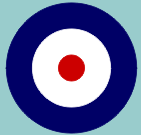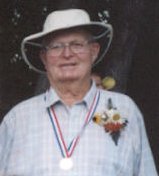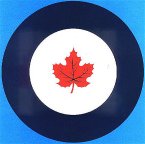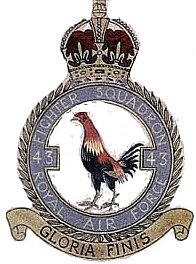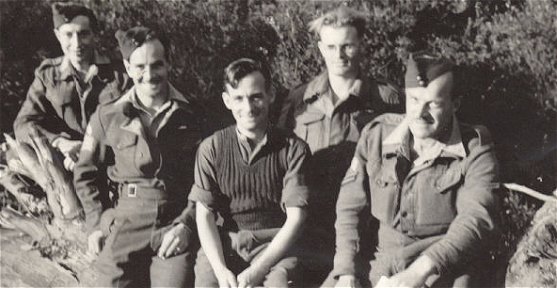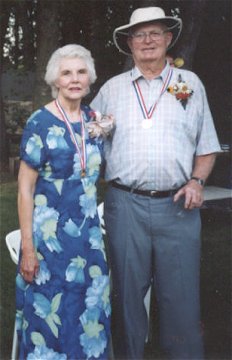.
An 'other ranks' memories of
43 Squadron
1942- 1945 [sixty years later]
Jack Tench and I were posted to 43 Sqn. from 535 Sqn. Sep.16 1942. We had
come from Canada in March '42 after having taken the AI radar course at
Clinton. Jack & I had spent a few 48s in London, where a meeting place
for Canadians was The Beaver club, and they would arrange tours. One place
we visited was the Salvation Army and they gave us turtleneck sweaters
-- the dress code on 535 was lax and we had been wearing them. Shortly
after we arrived at 43 a parade was called, and as we were dismissed by
WO Prior, he said, "I want to see the two Canadians back here in 5 minutes,
properly dressed," and so we met WO Prior. He was an OK guy, his bark was
worse than his bite.
We were shown around the squadron, stopped at a workshop and sat around
there talking. One fellow sat on a workbench with one leg over his other
knee, his pant leg up near the top of his socks. As we talked he kept fiddling
with a long slender screwdriver, tapping his leg with it, made one nervous
that he was going to injure himself. Suddenly he struck the handle with
his other hand, driving it completely through his leg so the tip showed
on the other side, sickening!. A great show, well staged, we didn't know
that he had an artificial one.
Then there was Corporal Bugg. I slept in the bed next to him. The beds
were those two-piece ones that came apart in the middle so during the day
they could be shortened. The mattress was three cushions that stacked up
with blankets on top. Every night, having made up his bed earlier, he would
come in late -- possibly from the wet canteen -- after the rest of us were
in bed. When he sat on his bed it would collapse and he seemed to think
that I was the culprit and would mutter comments on my ancestors. I pretended
to be asleep, but I would hear snickering around me. This went on for several
nights. That is the way it seemed to go, even when times got tough some
one would come up with a wisecrack and there would be laughter.
43 Squadron was preparing to go overseas so we did route marches, rifle
firing, threw grenades, were issued a tropical kit and sent on embarkation
leave. On Oct. 31 we loaded onto a troopship and left the Clyde on Nov.
1, 1942 -- destination unknown to us. There were lots of rumours about
where we were going, Burma being the hottest one. What I thought was odd
was that every morning when I got above decks the sun would be on a different
side, like we were going in circles.
Finally on Nov. 9 we were told that a landing had been made at Algiers
and we would be the next convoy to land. We went through the Straits of
Gibraltar at night, there were lights on the Spanish coast, Gibraltar was
in darkness but the shape of the rock could be seen against the sky. On
our right we could see the lights of Tangiers. At one time in the Med.,
our destroyer escort did some running around but there was no trouble,
and then on the morning of Nov. 12 we were heading in to Algiers. We passed
by a body in the water. The white buildings of Algiers looked clean, much
cleaner than it actually was. Funny how when approaching land, the land
looks so much higher and when approaching a large body of water, it looks
higher.
We disembarked with all our kit except our kitbags. We had our Sten
guns with 8 magazines, 25 rounds in each. Led by our adjutant, Flt Lt de
Pledge we marched the twelve miles to Maison
Blanche airfield. We stopped by a wall one time for a break and a French
woman picking oranges threw some to us. Our loaded trucks were going by
us, this time was the only time we marched, from then on we loaded the
trucks and climbed on too. We arrived at Maison Blanche with quite a few
stragglers, we had been told to conserve our water but we found cool water
at a hangar where we stopped. WO Prior took a couple of us to check out
some offices on a mezzanine, and when we came to a locked door, he drew
his pistol and shot the lock off, I thought, 'Hey, this is the real thing!’
The cooks stayed at that hangar for awhile on the north side of the
airfield, and we moved around to the east side where Jim Hillis and I slept
in the back of a hangar in a part that we had taken for a shop. That night
there was some air activity and the spent ack-ack landing on the tin roof
was noisy. I awoke next morning with a headache and realised that batteries
were being charged under the bench that I had slept on. I had not experienced
any bombing yet so thought "these guys are old hands, I'll see what they
do". Some were digging holes. The next night we slept in the same spot
but I didn't sleep on the bench. Jim said, "Let's get to sleep before the
bombing starts," so I went along with his way.
The next evening Eric Boutell, Jim and I walked down the road a few
miles where we had seen a bar on the way in and drank wine with the locals.
When we got back to the main gate a raid was just starting so we went across
the road into a vineyard near a Bofors gun. The Germans dropped parachute
flares that seemed to light up the whole area. It seemed that they flew
around waiting for ack-ack to ease off, then in a shallow dive make a run
across the field. They were dropping bombs in a stick of four. We had picked
a poor spot, one run was directly for us, one, two, three, each one getting
closer, for a split second it looked like there was no future there, but
the fourth landed past us very close and I was bouncing in the air. We
were OK, we had been told to keep our heads off the ground so we didn't
get concussion.
When the raid was over we started picking our way back to the airfield
by the light of one flare that was still up there, picking our way because
we had heard two bombs that had stopped whistling on the way down so we
knew that they had dropped canisters of spikes or anti personnel bombs
that opened on the way down to scatter. The spikes were made of sheet metal
with four points so that whatever way they fell there was always one point
up, they stood about three inches high for puncturing tires. The AP were
cans with spring loaded ends and sides so they would spring up when tripped.
The bomb disposal squad had collected some that had failed to open.
We had our tents set up in front of some hangars for a while but as
the American bombers started arriving we were moved to a field at the back
of the airfield. We still came across the airfield to use the washrooms
in the hangar. One morning we saw that a bomb had fallen midway between
three aircraft, which had burned the crew of one. The crew of a B17 had
apparently slept in it, and now they were removing chunks of burned bodies,
and a US officer was digging around one with his fingers looking for dog
tags.
Then the rains came and our field where we were camped turned into a
lake. After it had rained for some time, the wind got up and blew down
a lot of the tents whose stakes pulled out of the soft mud. Our tent held
but the water started coming in, when it reached Jim and I we took our
blankets and went looking for a better spot. The cooks had a mobile kitchen
set up in the field, and Jim found a spot on some crates under the trailer.
I stretched out on a serving table -- I was in the rain but I wasn't lying
in water. Our tent was by a creek, so the next day we cut a lot of canes
that grew there and piled them in the tent to raise us over the mud.
One day, while we were in that spot, we heard shouting coming from a
nearby field. When we went to check it out we saw a French armed guard
with a whip, driving a number of prisoners, political prisoners, someone
said, across the field in line abreast on the run, seeding grain by hand.
Some of the tents were so buried in the mud that they were unsalvageable
and we were moved to a farmyard where there was a large wine storage building,
a drive through building with concrete vats on each side. They were about
ten feet high by about eight feet square, and the tops were solid concrete
with manholes in each vat. There was room on top for us to sleep with our
heads against the wall and still room for people to walk past our feet.
Some also slept in the passageway. This is where we stayed for the rest
of the time that we were at Maison Blanche. Now the two flights went on
24-hour shifts, 24 on the airfield and 24 hours off. If it was a quiet
night on the airfield we slept, if it wasn't, we didn't.
A Beaufighter landed at dusk one evening
to be refuelled. Our fuel at that time was in four-gallon square tin cans,
two cans in a waxed cardboard box. We all pitched in, formed a line to
open the cans with our Swiss army knives, some on the wings to pass the
cans to, hurrying to get it done before bomber time. We were glad to hear
the next day that they shot down five bombers that night. It seemed a backward
way to be handling fuel, there were dumps of it scattered around the airfield,
but I remember one night when a dump was hit and burning, helping to move
cases from one end while the crash tender dumped foam on the other and
the fire was put out and the dump was saved.
WO Prior took some of us at the beginning of one raid to load fuel on
a truck, go down the road on the north side of the field and light dummy
fires. We dumped a pile and he would light it, we made three fires and
drove on - - and came to a dead end and had to go back past the fires but
luckily the bombers had by then gone home.
I sprained an ankle one night during a raid. It was on our twenty-four
hours off the airfield. We heard the siren at the airfield and ran outside
to watch. There was a curb around the manholes in the top of the vats and
I slipped off one of them. The bombers were making their runs directly
overhead and we could hear a clang when they opened the bomb doors. There
was a good fireworks display when we weren't on the target.
It was thought one night that we might be hit by paratroops, or it could
have been an exercise, but Jim Hillis and I spent the night with our Sten
guns at the end of the runway near the administration buildings and hospital.
Off to the side of the end of the runway work was being done to make a
pad, earth had been removed and the hole filled with rocks. It was a very
calm night; there was ack-ack over the harbour at Algiers about ten air
miles away. We heard a single aircraft coming over from that direction
and then overhead we heard a flapping noise. Jim said, "That's a landmine."
We quickly moved enough rocks so that we were below ground level before
it hit, it seemed to take quite a while to come down. In the morning at
the end of our shift we went to see where it hit. The hospital was badly
damaged; there were a lot of pieces of silk and shroud lines. I took some,
the silk for a scarf and the line for my identity disks, the line was easier
on my neck than what I had, then the truck was there to pick us up. We
didn't know then that our Medical orderly had been standing in front of
the hospital and had been decapitated. If we had known that he was there
we could have shouted to him to get down, he might have survived. He had
bandaged my ankle when I sprained it.
An Arab would come on the airfield selling oranges -- good oranges and
cheap -- so we ate a lot of them. One of the fellows got a parcel from
home and there was an orange in it. It seemed a shame; they must have been
very scarce in Britain. In one of the parcels that I got from home my mother
had sent a jar of canned chicken but the jar had been broken, didn't smell
too good.
I mentioned with one of my pictures that a bomb had fallen close to
the tent where I slept. That night I was standing in front of the tent
listening to aircraft coming in from a dusk patrol, then it sounded like
one was doing a go around, but a German bomber had followed them in, circled
the airfield, came up the east side and dumped his load on the road that
followed the fence line. I never heard one like that one, no whistling
just a roaring, rushing sound. My hat was two steps away on a crate inside
the tent but no time to get it. I don't remember a shot being fired at
it.
We got in to Algiers quite often except when Darlan was assassinated,
then it was out of bounds for a week or so. One time we saw a troop of
French Foreign Legion ride by on their white horses.
When we left Maison Blanche in the spring, we in the advance party were
flown ahead in a DC3 to near a place called Jemmapes, a runway built by
the sappers, there is a picture of that place.
We made several stops on our way to Tunis;
the next spot was at a place where there was a steep hill back of the camp.
The wireless people had an antenna on the top; it was too steep for a Jeep
to climb, so an Arab was hired with his donkey to haul supplies to the
top. I think it was at that spot where we heard an explosion; the Germans
had blown up a rail line and mined one crater, when the crater was being
filled, it blew and there were casualties. A little later WO Prior called
to us who were the closest to hurry and carry a stretcher with a blanket-covered
person back to our camp. When we got there we pulled back the blanket,
there had been no rush, the body was headless.
I seem to remember one of these places was called Djebel Abiod. There
were Roman baths near one of our stops and we went there a few times and
also swam off the rocks there. That was the first time that I had swum
in salt water and was surprised at the difference in buoyancy. At our last
stop before Tunis truckloads of German POWs were going by heading west
with one British soldier with a rifle sitting on the cab facing backwards.
Our last stop in North Africa was at Sfax; we must have been getting
close to the Sahara because we were getting sand in our food. We were there
for a few days, waiting for an LST to take us to Malta. I remember going
to sleep one night on the warm sand and waking up cold later and being
surprised at how quickly it had cooled off. We were getting a forces program
beamed at us (in English) from Germany, that was the first time we heard
Lillie Marlene who was so popular with the Allied forces.
Later when we were in Southern France on our way up to Lyons we stopped
at a town one night and some of us drank at a bar with some locals and
members of the Maquis. As the evening progressed there was singing -- I
knew most of the words of La Marseilles at one time. When one of
our group started singing Lillie Marlene the French wanted no part
of that, they had heard it enough. One night at Sfax the German singer
said, "I'm going to dedicate my next song to you boys ready to leave North
Africa," and she sang How Deep is the Ocean.
We had an uneventful trip to Malta and were there until the Sicily landing
while our pilots did sweeps, then back onto an LST to Sicily. We had expected
to be bombed on Malta, it had been bombed so much but it had been quiet.
On our way to Sicily that night we looked back and saw ack-ack, Malta was
being bombed again. We landed near Pachino and drove on very dusty roads
to an airfield that had recently been taken by paratroops.
We spent the first night under some large trees, there was a little
air activity that night, a lot of ack-ack but nothing falling close except
for a lot of spent ack-ack, so some of us took cover lying beside a large
wooden crate. Then someone said, "There's a bomb in this crate!" Someone
else said, "If we get a direct hit, what's the difference?” So we stayed.
We stayed under those trees for several nights, but since we were at the
edge of a bomb dump we moved out into a field of grapes and slept between
the rows. The grapes were ripe then.
We had been issued with mosquito nets and two hoops that we could stick
into the ground to hold them. We had also been issued with half a two-man
pup tent each that would also serve as a ground sheet; the weather was
dry so we just slept under the nets. They were white, so they showed up
well at night. We acquired a large battery-operated console radio and set
that up amongst us. At night we would gather around it and listen to the
BBC for the latest news that we were making, the forces program, and the
songs of Vera Lynn. When that was over there would be silence for a while,
then someone would start singing and others would join in, not loud drinking
songs, but quiet songs of lonesome men thinking of home. (I have written
more of this spot, with my pictures.)
When the larger aircraft came we moved back to a landing strip near
Pachino, we were near the beach where we had landed. Trucks would take
us to there at times. One day I had a day off so took a book, went on the
morning truck and stayed for the day. During the day nature called and
I headed back into some sand dunes, [the beach was deserted] but before
I got very far I saw a tank mine sticking out of the sand so went no further.
That evening as I got on a truck that was going back to camp, a man leading
a horse, that was pulling a cart with a woman and child on it went by,
heading into the dunes. Before we left there was a boom and the man and
horse were killed.
One evening as we were lined up for supper, an ME 109 flew past at tree
top level, we all scattered, the ack-ack guns opened up, we were on a rise
where we could see the airstrip, a Spit took off and got on the tail of
the 109 -- and waggled his wings. The 109 was one from the last airfield,
flown by one of our pilots. The two aircraft landed safely, the 109 landed
on one wheel, the other had hung up, but the pilot held it there until
it had slowed down.
Our next move as the war in Sicily ended
was to the north coast of Sicily near Messina. The airstrip was very near
the beach. We slept on the slopes of Mount Etna on one night of our move.
We swam there a few times, near the airstrip -- there was quite an undertow
when the waves were high. None of the local population came near. I walked
down the beach one day, up ahead was a sign, but I could see nothing on
it. As I went past it I looked back and read 'Achtung Minen' so I followed
my tracks back.
We crated our equipment again and stamped D+3 on it. I don't remember
our trip to Salerno, but on the morning of D+3 when we went above decks
we were in the harbour at Salerno waiting for our turn to land. There was
quite a bit of action An American amphibious craft called a DUKW was unloading
cargo from one ship, and when it reached shore it drove inland with its
load. A cruiser or a battleship was moving around the harbour, firing inland.
We were seeing splashes in the water but none were close. When enemy aircraft
came over we were sent below.
Then it was our turn to land. our trucks had been waterproofed to go
through four feet of water but we were able to drive onto the beach. As
we drove off we spotted one of our pilots walking on the beach, he had
made a forced landing on or near the beach, he had got wet, his clothes
were stained yellow from the marker dye they carried to make them more
visible to air sea rescue.
Ours was the last truck of our group to come off the LST. As we came
to an intersection we were held up by the MPs to let more urgent traffic
by so we got separated from the rest. We turned left at a crossroad but
didn't get far before we came to a 'MASH’ style first aid post -- end of
the road so went back and found another road leading inland. We saw hangars
ahead but before we had gone far, a soldier in the ditch said that the
Germans were still there.
On our third try we were successful. We came to a row of twenty-five
pounders along the road, firing across our newly constructed airstrip.
At the end of the runway was a grove of walnut trees and that was where
we found the rest of our group. We were to wait there a week or more before
our aircraft came. We dug individual slit trenches about a foot deep to
sleep in. The first night was the noisiest with bombing and shelling and
the sound of tanks running around. One of our fellows talked to the twenty-five
pounder gunners the next morning and was told that they had had their range
down to a thousand yards.
We cut sticks and draped our ground sheets over our sleeping trenches
with a stick holding each corner up to keep the dew off. I woke one night,
I had been sleeping on my back and felt something crawling between my shoulder
blades, and it felt like a three-foot snake. I was able to grab it through
my shirt and off it came -- it was just a small six-inch lizard looking
for a warm spot. Another night we had a little rain and when I awoke in
the morning my ground sheet was full of water and I could see that there
was no way that I could get out without dumping it all onto my blankets.
We watched P38s bombing the airfield that we had almost got to -- coming
in, in shallow dives. One time two or more squadrons of B25s came over
in close formation and seemed to drop all of their bombs at once. I saw
a flight of P38s high overhead one time, flying in a circle with a German
fighter after them, nothing came down.
Not far away there was a large barn and through the open loft windows
we could see tobacco leaves hung to dry. Some of the fellows got some and
rolled them into cigars but I never tried them.
A B17 made an emergency landing on our strip one day and while they
were fixing their problem we talked to some of the crew. They asked about
the dust and smoke and noise coming from a spot further down the shore,
and we told them that the Germans were shelling that headland. Boy, they
said, "We wouldn't want your job." We said, "Well, we wouldn't want your
job either."
One of the large walnut trees had been knocked down and the walnuts
were ripening so we ate some of them. When we left that spot we took a
sandbag full with us. The beachhead was pushed inland enough so that our
aircraft could come. We still stayed at our same spot and in the morning
after we had eaten we would walk down to our tent workshop that was beside
the runway, halfway down. At the end of the runway, by the walnut trees,
a strip had been cleared to make an ELL. Inside the ELL was a field hospital.
At the school in Naples one night we were eating some of the nuts. We
were breaking them by hitting them on the stone floor with the butt of
our sten guns. Sometimes they would scatter. Then someone found that by
holding two of them in our fist we could break them by squeezing them.
The night that some of us stood for awhile under the arch in the hallway
while bombs were falling nearby, someone more learned was talking, in the
dark, about arches. He mentioned about how strong they were, which was
reassuring. With the end of a stone wall on either side, he said, the wedge
shaped rocks were placed from either side on a form. Then when the keystone
was put in place, it was self-supporting. Next day I had a good look at
it and there in the middle was the keystone, the shape of our Manitoba
map.
As I walked past Matt Graham's spot one
morning on my way to our workshop tent he said, "Wait and I'll walk with
you," so I was standing at the end of his slit trench and beside a walnut
tree. We heard an aircraft diving but there were low scattered cumulus
clouds and we could see nothing Then it appeared around a cloud diving
at us. Someone yelled, "It's a Jerry!" For a split second I thought, 'if
he's going to strafe I should stand behind this walnut tree, but if it's
a bomb only, get down.' I dropped into Matt's trench with Matt a close
second. I heard a lot of remarks about uninvited guests for a long time
after that. Matt, his friend Bill and I had done a pub-crawl down Straight
Street in Valetta when we were in Malta. The bomb landed near the field
hospital and there were casualties there, but none of our crew was hit,
although most were still in the area.
Jim Hillis and I were in our tent workshop one time when all the ack-ack
in the area opened up and it got quite noisy. There was a shallow ditch
along the edge of the field we were in, about fifty yards away, and we
had planned on going there if prudent. Jim was looking for his helmet and
I was waiting for him when I heard a different noise and hit the deck,
taking Jim with me. In the tent we had a makeshift workbench in the middle
and packing cases, some of them empty, along both low sides. The raid was
soon over; it had been a hit and run. The bomb had landed nearby on the
runway and the rigger and fitter from one aircraft had been hit but they
survived.
Then someone said " there's a hole in your tent" I looked and there
was a hole in one side near the bottom. I said " that must be an old one
because Jim and I were lying right there inside”. We looked and sure enough
a piece of shrapnel had come through the tent, through an empty packing
case, bounced off our workbench, through some more cases and we found the
piece still in the tent. It was a rivet holding two pieces of jagged metal
together. That was the different noise that I had heard as it came in past
my ankle before we went down. Sometimes, I guess, it's good to be late.
As the front moved back we moved to another 'custom made' airstrip,
and then the rains came and a lot of the Spits were stuck in the mud. I
recall helping to push them out, rocking the wingtips. When we were ordered
to move from that spot, it was a matter of holding them back while the
pilot revved it up. I can still see a Spit clawing at the sky at about
a forty-five degree angle with the tail wheel on or very near the ground,
and making it. (Well, OK, maybe less than 45.)
~ Lloyd (Slim) Snell
March 25 2002
